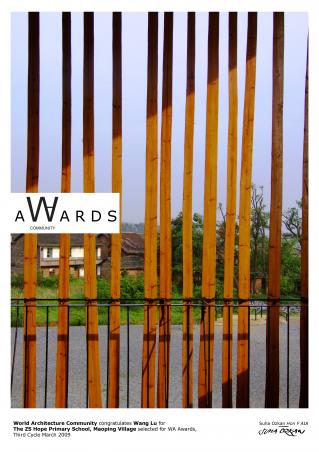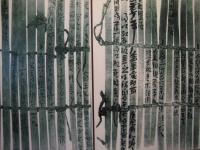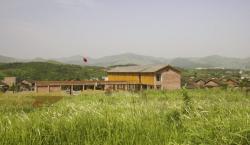Sponsor: Zhejiang Association of Commerce in Hunan
Location: leiyang, Hunan province, China
Completed:2007.12
Architects:in+of Architecture/Studio WANG Lu, Tsinghua University
Design team: Wang Lu, Lu Jiangsong, Huan Huaihai, Zheng Xiaodong
Construction: Farmers from Maopingcun Village
Site area:5 273 m2
Total floor area:1 168 m2
Building cost: 300 000 RMB
Photos:Christians Richter?Wang Lu
Project description:
On July 19, 2006, rainstorms and mountain floods caused by Typhoon “Bilis” destroyed the original buildings of the primary school in Maoping Village. Zhejiang Association of Commerce {ZS} in Hunan Province urgently raised 500,000 RMB on July 29, 2006 for building a new primary school—the ZS Hope Primary School, Maoping Village. The money was to be used for ground-leveling, playground facilities, desks and blackboards, school uniforms, and so on. The total floor area of the school is 1,168m2, and the actual construction {including interior plaster rendering} cost is 300,000 RMB, which amounts to 300 RMB per square meter.
Voluntarily undertaking the task of designing the Hope Primary School, our studio started site analysis on August 5, 2006. Together with local villagers, we constructed this new primary school on December 8, 2007, the whole process having lasted for sixteen months.
Leiyang, which is located in the south part of Hunan province, is the home place of Cai Lun, the inventor of paper-making in the Eastern Han Dynasty {25-220 CE}. Maoping, which is 30 kilometers to the south of Leiyang, is a small mountain village with its simple folkways. Surrounded by hills on all sides, the village and its houses continuously spread out by following the topographical contours of hills and valleys, with the ancestral shrine at its center. Along with the development of economy and the advancement of urbanization, great changes are taking place in the Maoping Village, as in the vast rural areas of China.
Our design began with learning local residents’ way of life and interpreting local residential buildings. Containing solutions for local design problems, local experience of building formed a basis for our exploration of new architectural expressions. With a Modernist sensibility, we sought to invoke the essential spirit of local culture, and at the same time relate it with contemporary life. In this way, not only is the new primary school endowed with memory of the past, keeping alive the good tradition of local residential buildings in their appropriate adaptation to the local conditions, but while revealing local characteristics, it can also open-heartedly constitute a place with a spirit of the times and a real sense of culture, so as to expand the values of local culture, and represent the humanistic character of the particular building type as embodied in the Hope Primary School.
The site of the primary school is on the slope in the northeast of the Maoping Village. The two-story school building stands on a terraced ground that is embedded in the slope. The configuration, cross-section, materials and colors of the building are basically isomorphic to local houses, and the scale of its gables is largely commensurate with the surrounding houses. The division of the structure by small sky-wells that correspond to teachers’ offices and staircases renders the whole building resembling a cluster of local houses; through the breaking-up of the whole, the school amicably blends with the local environment. In order to keep the construction cost under control and to adapt the project to the local construction techniques, bricks are still employed as the main building materials: red bricks are used for the building so as to have a better dialogue with the surrounding houses; whereas the limited amount of those surviving large grey bricks are applied to roads, paths, and open grounds.
The northern brick façade has a few brick lattice works piercing through each of the wall, a measure of architectural treatment<
2006
2007
The ZS Hope Primary School, Maoping Village by Wang Lu in China won the WA Award Cycle 3. Please find below the WA Award poster for this project.

Downloaded 223 times.
.jpg)

.jpg)
.jpg)





